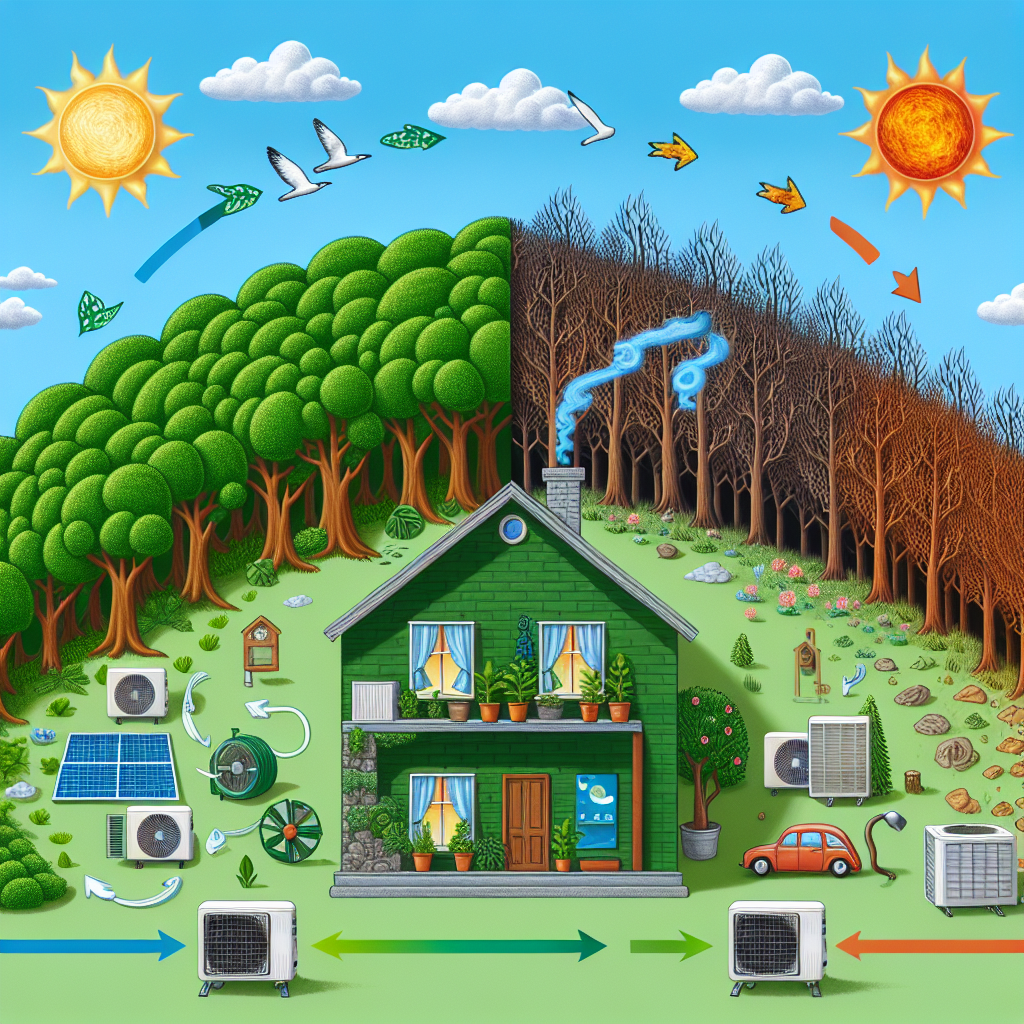Your cart is currently empty!
Tag: Choices

The Environmental Impact of Air Conditioning and How to Make Greener Choices
Air conditioning has become a staple in many homes and buildings around the world, providing a much-needed respite from the sweltering heat during the summer months. However, the environmental impact of air conditioning is significant and cannot be ignored. From the energy consumption required to run these systems to the refrigerants used in the cooling process, air conditioning contributes to greenhouse gas emissions and exacerbates climate change.One of the main environmental concerns associated with air conditioning is its high energy consumption. According to the U.S. Department of Energy, air conditioning accounts for about 6% of all the electricity produced in the United States. This high energy demand puts a strain on power grids and increases the production of greenhouse gases, primarily carbon dioxide, which contribute to global warming. In addition, the refrigerants used in air conditioning systems, such as hydrofluorocarbons (HFCs), are potent greenhouse gases that have a high global warming potential.
To minimize the environmental impact of air conditioning, there are several steps that individuals and businesses can take to make greener choices. One of the most effective ways to reduce energy consumption is to invest in energy-efficient air conditioning systems. Look for units that have a high energy efficiency rating, such as ENERGY STAR certified models, which can help reduce energy usage and lower utility bills.
Another way to make greener choices when it comes to air conditioning is to properly maintain and service your system. Regular maintenance, such as cleaning or replacing air filters, can help improve the efficiency of your air conditioning unit and prolong its lifespan. Additionally, ensuring that your home is properly insulated and sealed can help reduce the need for excessive cooling and improve energy efficiency.
When it comes to refrigerants, there are more environmentally friendly options available that have lower global warming potential. Look for air conditioning systems that use alternative refrigerants, such as hydrofluoroolefins (HFOs), which have a lower impact on the environment. Additionally, consider recycling or properly disposing of old refrigerants to prevent them from leaking into the atmosphere and contributing to climate change.
In conclusion, the environmental impact of air conditioning is significant, but there are ways to make greener choices and reduce its negative effects on the planet. By investing in energy-efficient systems, properly maintaining and servicing your air conditioning unit, and choosing environmentally friendly refrigerants, you can help minimize the environmental impact of cooling your home or building. Making these small changes can make a big difference in the fight against climate change and create a more sustainable future for generations to come.

Making Informed Choices: Selecting the Right Baby Milk for Your Child’s Needs
As a parent, one of the most important decisions you will make for your child is what type of baby milk to feed them. With so many options available on the market, it can be overwhelming to decide which one is best for your little one. Making an informed choice is crucial to ensure your child receives the proper nutrition they need to grow and develop.When selecting the right baby milk for your child, there are several factors to consider. It is important to first understand the different types of baby milk available, including formula milk, cow’s milk, and plant-based milk alternatives. Formula milk is specifically designed to mimic breast milk and provide all the necessary nutrients for your baby’s growth and development. Cow’s milk is not recommended for babies under one year old due to its high protein and mineral content, which can be difficult for infants to digest. Plant-based milk alternatives, such as soy, almond, or oat milk, may not provide all the necessary nutrients needed for proper growth and development in infants.
It is also important to consider any specific dietary needs or allergies your child may have when selecting baby milk. Some babies may have allergies or sensitivities to certain ingredients, such as lactose or soy, which can cause digestive issues or skin reactions. In these cases, it is important to consult with a pediatrician or allergist to determine the best type of baby milk for your child’s needs.
Another factor to consider when selecting baby milk is the age and stage of development of your child. Infants under six months of age should be fed breast milk or formula milk exclusively, as they provide all the necessary nutrients for proper growth and development. As your child gets older and begins to eat solid foods, you may choose to introduce cow’s milk or plant-based milk alternatives as a supplement to their diet.
When selecting baby milk, it is important to read the labels carefully and choose a product that is fortified with essential nutrients such as iron, calcium, and vitamin D. These nutrients are crucial for your child’s growth and development and may not be present in all types of baby milk. Additionally, it is important to choose a reputable brand that follows strict quality control standards to ensure the safety and purity of their products.
In conclusion, making an informed choice when selecting the right baby milk for your child is crucial to ensure they receive the proper nutrition they need to grow and develop. By considering factors such as your child’s age, dietary needs, and stage of development, you can make the best decision for your little one’s health and well-being. Consult with a pediatrician or healthcare provider if you have any questions or concerns about selecting baby milk for your child’s needs.

The Psychology of Interface Design: How User Behavior Influences Design Choices
Interface design is a crucial aspect of creating successful digital products. From websites to mobile apps, the way users interact with a platform can greatly impact their overall experience. But what exactly goes into designing interfaces that are both visually appealing and user-friendly? The answer lies in understanding the psychology behind user behavior and how it influences design choices.One key psychological principle that designers must consider is cognitive load. Cognitive load refers to the amount of mental effort required to complete a task. When designing an interface, it’s important to minimize cognitive load by presenting information in a clear and organized manner. This can be achieved through techniques such as using consistent navigation, limiting the number of options on a screen, and providing visual cues to guide users through the interface.
Another important aspect of interface design is the concept of affordances. Affordances are visual or sensory clues that suggest how an object should be used. For example, a button that looks like it can be clicked on or a slider that can be dragged. By designing interfaces with clear affordances, users are able to quickly understand how to interact with the platform and complete tasks more efficiently.
Furthermore, designers must also consider the concept of mental models. Mental models are the internal representations that users have of a system based on their past experiences and expectations. By aligning the interface with users’ mental models, designers can create a more intuitive and user-friendly experience. For example, using familiar icons and terminology can help users quickly understand how to navigate a platform.
In addition to cognitive load, affordances, and mental models, designers must also consider the emotional aspects of interface design. Emotions play a significant role in how users perceive and interact with a platform. By incorporating elements such as color psychology, typography, and visual hierarchy, designers can create interfaces that evoke the desired emotional response from users.
Ultimately, the psychology of interface design is a complex and multifaceted field that requires a deep understanding of user behavior. By taking into account cognitive load, affordances, mental models, and emotions, designers can create interfaces that are not only visually appealing but also intuitive and user-friendly. By putting user behavior at the forefront of design choices, designers can create digital products that truly resonate with their target audience.

The Environmental Impact of Storage Devices: How to Make Sustainable Choices
In today’s digital age, storage devices play a crucial role in our everyday lives. From storing important documents and photos to housing entire music and movie collections, storage devices have become essential tools for managing our digital information. However, the environmental impact of these devices is often overlooked. The production, use, and disposal of storage devices can have a significant impact on the environment, but there are ways to make more sustainable choices when it comes to storage.One of the biggest environmental concerns associated with storage devices is the energy consumption during their production and use. The manufacturing process of storage devices requires a significant amount of energy, often coming from non-renewable sources such as fossil fuels. Additionally, the ongoing use of storage devices also contributes to energy consumption, especially for devices that are left on or in standby mode for extended periods of time.
To make more sustainable choices when it comes to storage devices, consumers can opt for devices that are designed to be energy-efficient. Look for devices with low power consumption ratings or features such as automatic power-saving modes that can help reduce energy usage when the device is not in use. Additionally, consider using cloud storage services that can help reduce the need for physical storage devices altogether.
Another environmental concern related to storage devices is the disposal of old or outdated devices. Electronic waste, or e-waste, is a growing problem around the world, with millions of tons of electronic devices ending up in landfills each year. Many storage devices contain harmful materials such as lead, mercury, and cadmium that can leach into the soil and water supply if not properly disposed of.
To make more sustainable choices when it comes to disposing of storage devices, consider recycling or donating old devices instead of throwing them away. Many electronics retailers and manufacturers offer recycling programs that allow consumers to safely dispose of their old devices. Additionally, some organizations accept donations of old devices that can be refurbished and reused by those in need.
In conclusion, the environmental impact of storage devices is a significant concern that should not be ignored. By making more sustainable choices when it comes to the production, use, and disposal of storage devices, consumers can help reduce their environmental footprint and contribute to a healthier planet. From choosing energy-efficient devices to recycling old devices, there are a variety of ways to make more sustainable choices when it comes to storage devices. By taking these steps, we can all do our part to protect the environment for future generations.
